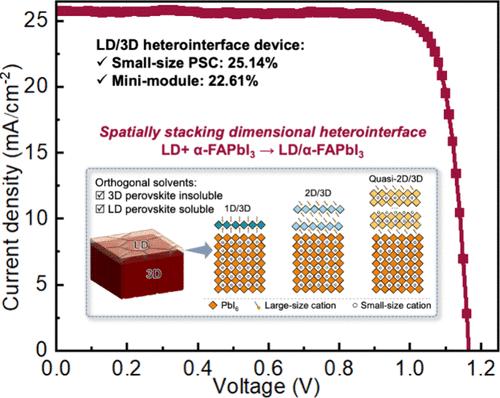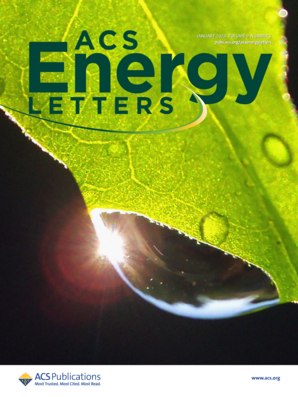Orthogonal Solvent Approach in Dimensionality-Heterointerface Perovskite Photovoltaics
IF 19.3
1区 材料科学
Q1 CHEMISTRY, PHYSICAL
引用次数: 0
Abstract
Constructing low-dimensionality/three-dimensionality (LD/3D) perovskite heterointerfaces is a well-established strategy to enhance the perovskite photovoltaic performance. Here, we introduce a solvent-orthogonality approach to precisely tailor the structure and dimensionality of LD perovskites within LD/3D perovskite heterointerfaces, thereby optimizing interfacial energetics. In this approach, LD perovskite precursors, comprising both organic and inorganic components, are dissolved in a mixed acetonitrile and 1,2-dimethoxyethaane solvent system and deposited onto a 3D perovskite layer with minimal impact on the substrate. Unlike traditional cation-exchange methods that focus solely on organic components, our strategy enables the growth of dimensionally tailored LD stacks (1D, 2D, and quasi-2D configurations), forming effective LD/3D heterointerfaces. This optimization improves carrier kinetics at the perovskite-charge transport layer, resulting in an n-i-p device efficiency of 25.14% and solar modules (18 cm2 active area) with 22.61% efficiency. Our solvent-orthogonality strategy presents a promising method for engineering perovskite heterointerfaces in various photovoltaic applications.

维度-异界面包晶光伏技术中的正交溶剂方法
本文章由计算机程序翻译,如有差异,请以英文原文为准。
求助全文
约1分钟内获得全文
求助全文
来源期刊

ACS Energy Letters
Energy-Renewable Energy, Sustainability and the Environment
CiteScore
31.20
自引率
5.00%
发文量
469
审稿时长
1 months
期刊介绍:
ACS Energy Letters is a monthly journal that publishes papers reporting new scientific advances in energy research. The journal focuses on topics that are of interest to scientists working in the fundamental and applied sciences. Rapid publication is a central criterion for acceptance, and the journal is known for its quick publication times, with an average of 4-6 weeks from submission to web publication in As Soon As Publishable format.
ACS Energy Letters is ranked as the number one journal in the Web of Science Electrochemistry category. It also ranks within the top 10 journals for Physical Chemistry, Energy & Fuels, and Nanoscience & Nanotechnology.
The journal offers several types of articles, including Letters, Energy Express, Perspectives, Reviews, Editorials, Viewpoints and Energy Focus. Additionally, authors have the option to submit videos that summarize or support the information presented in a Perspective or Review article, which can be highlighted on the journal's website. ACS Energy Letters is abstracted and indexed in Chemical Abstracts Service/SciFinder, EBSCO-summon, PubMed, Web of Science, Scopus and Portico.
 求助内容:
求助内容: 应助结果提醒方式:
应助结果提醒方式:


